
Balaenoptera is a genus of rorquals containing eight extant species. Balaenoptera comprises all but two of the extant species in its family ; the genus is currently polyphyletic, with the two aforementioned species being phylogenetically nested within it.

Otodus megalodon, commonly known as the megalodon, is an extinct species of giant mackerel shark that lived approximately 23 to 3.6 million years ago (Mya), from the Early Miocene to the Pliocene epochs. O. megalodon was formerly thought to be a member of the family Lamnidae and a close relative of the great white shark, but has been reclassified into the extinct family Otodontidae, which diverged from the great white shark during the Early Cretaceous.
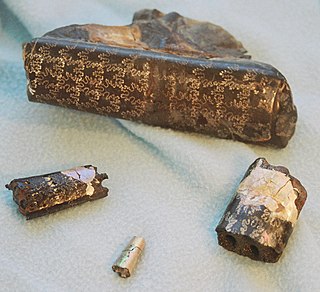
Baculites is an extinct genus of heteromorph ammonite cephalopods with almost straight shells. The genus, which lived worldwide throughout most of the Late Cretaceous, and which briefly survived the K-Pg mass extinction event, was named by Lamarck in 1799.

Quinkana is an extinct genus of mekosuchine crocodylians that lived in Australia from about 28 million to about 10,000 years ago. Most attributed specimens have been found in Queensland. It is speculated to have been one of the top predators of Pleistocene Australia.

Ontocetus is an extinct genus of walrus, an aquatic carnivoran of the family Odobenidae, endemic to coastal regions of the southern North Sea and the southeastern coastal regions of the U.S. during the Miocene-Pleistocene. It lived from 13.6 mya—300,000 years ago, existing for approximately 13.3 million years.
Eogavialis is an extinct genus of eusuchian crocodylomorph, usually regarded as a gavialoid crocodylian. It superficially resembles Tomistoma schlegelii, the extant false gharial, and consequently material from the genus was originally referred to Tomistoma. Indeed, it was not until 1982 that the name Eogavialis was constructed after it was realised that the specimens were from a more basal form.
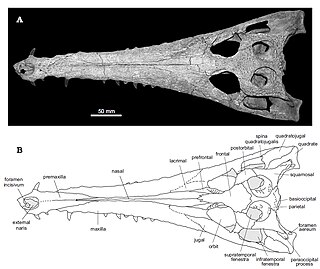
Eosuchus is an extinct genus of eusuchian crocodylomorph, traditionally regarded as a gavialoid crocodilian. It might have been among the most basal of all gavialoids, lying crownward of all other known members of the superfamily, including earlier putative members such as Thoracosaurus and Eothoracosaurus. Fossils have been found from France as well as eastern North America in Maryland, Virginia, and New Jersey. The strata from which specimens have been found date back to the late Paleocene and early Eocene epochs.

Euthecodon is an extinct genus of long-snouted crocodile. It was common throughout much of Africa during the Neogene, with fossils being especially common in Kenya, Ethiopia, and Libya. Although superficially resembling that of gharials, the long snout was a trait developed independently from that of other crocodilians and suggests a diet of primarily fish. Euthecodon coexisted with a wide range of other crocodiles in the areas it inhabited before eventually going extinct during the Pleistocene.

Syrinx aruanus, common name the Australian trumpet or false trumpet, is a species of extremely large sea snail measuring up to 72 cm long and weighing up to 18 kg. It is a marine gastropod mollusk in the family Turbinellidae, and is the only species in the genus Syrinx.
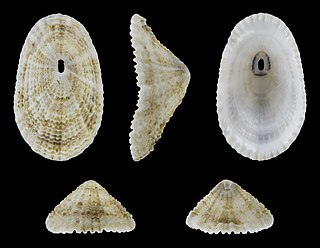
Diodora graeca, the Greek keyhole limpet, is a sea snail or limpet, a marine gastropod mollusk in the family Fissurellidae, the keyhole limpets.

Conus harlandi is a species of sea snail, a marine gastropod mollusk in the family Conidae, the cone snails and their allies.

Lusitanops expansus is a species of sea snail, a marine gastropod mollusk in the family Raphitomidae.
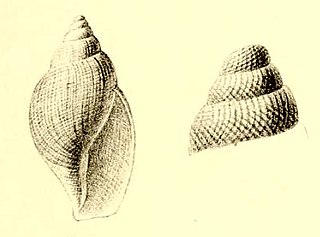
Lusitanops is a genus of sea snails, marine gastropod mollusks in the family Raphitomidae.

Livyatan is an extinct genus of macroraptorial sperm whale containing one known species: L. melvillei. The genus name was inspired by the biblical sea monster Leviathan, and the species name by Herman Melville, the author of the famous novel Moby-Dick about a white bull sperm whale. It is mainly known from the Pisco Formation of Peru during the Tortonian stage of the Miocene epoch, about 9.9–8.9 million years ago (mya); however, finds of isolated teeth from other locations such as Chile, Argentina, United States (California), South Africa and Australia imply that either it or a close relative survived into the Pliocene, around 5 mya, and may have had a global presence. It was a member of a group of macroraptorial sperm whales and was probably an apex predator, preying on whales, seals and so forth. Characteristically of raptorial sperm whales, Livyatan had functional, enamel-coated teeth on the upper and lower jaws, as well as several features suitable for hunting large prey.

Oxygyrus keraudrenii is a species of sea snail, a holoplanktonic marine gastropod mollusk in the family Atlantidae.

Enhydriodon is an extinct genus of mustelids known from Africa, Pakistan, and India that lived from the late Miocene to the early Pleistocene. It contains 9 confirmed species, 2 debated species, and at least a few other undescribed species from Africa. The genus belongs to the tribe Enhydriodontini in the otter subfamily Lutrinae. Enhydriodon means “otter tooth” in Ancient Greek and is a reference to its dentition rather than to the Enhydra genus, which includes the modern sea otter and its two prehistoric relatives.
Raphitoma antonjanseni is an extinct species of sea snail, a marine gastropod mollusc in the family Raphitomidae.
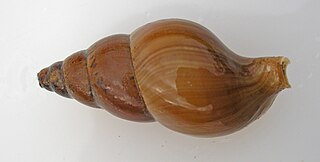
Neptunea smirnia, the chocolate whelk, is a species of sea snail, a marine gastropod mollusk in the family Buccinidae, the true whelks. It was first described to science by William Healey Dall in 1919. The type specimen was collected from the Strait of Juan de Fuca in 114 fathoms of water.

Vasum turbinellus is a species of gastropods belonging to the family Turbinellidae.

Drazinderetes is a large bodied genus of soft shell turtle from the Middle Eocene Drazinda Formation of Pakistan. Its presence in the shallow marine deposits of the Drazinda Formation suggests that Drazinderetes may have been a partially or fully marine animal. Indetermined trionychine remains from the same formation may suggest that Drazinderetes could have been among the largest known turtles, with one entoplastron indicating a potential length of 1.5 to 2.1 meters. Drazinderetes currently consists of only a single species: Drazinderetes tethyensis.

















